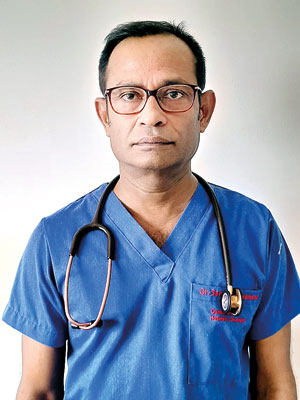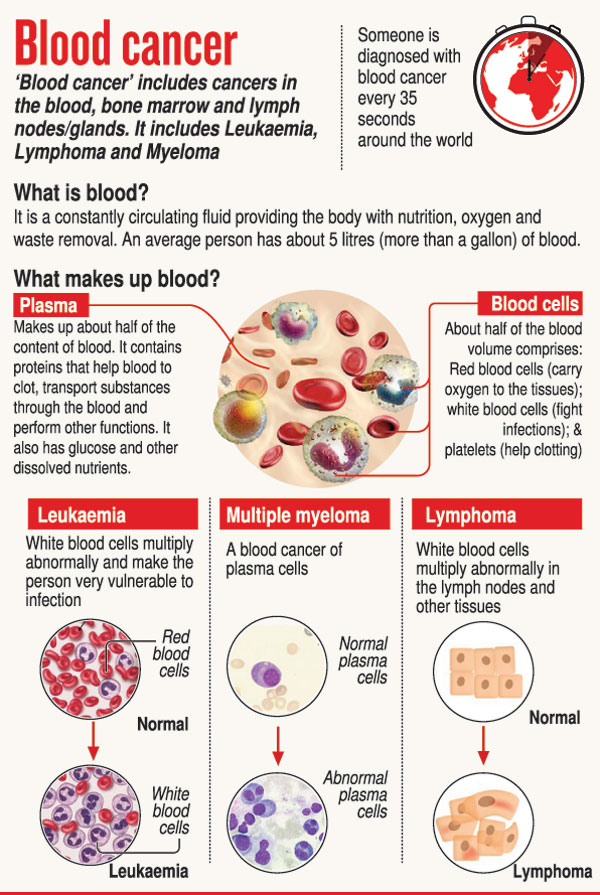News
Battling blood cancer: Survivors’ tales bring hope
- A recent study published in prestigious British journal highlights outcomes and successful applicability of treatment and supportive care protocols with regard to Sri Lankan patients
- Consultant Haemato-oncologist Dr. Saman Hewamana stresses importance of timely diagnosis and appropriate medicine for chance of survival

A tale of life and hope and a strong underlying message.
Seek treatment immediately if diagnosed with Acute Myeloid Leukaemia (AML) and keep to the treatment protocols.
This is not just hearsay but comes from a study published in the prestigious journal of the British Society of Haematology about survival rates of Sri Lankan patients with AML.
It is believed to be the only documented study relating to outcomes and successful applicability of western treatment and supportive care protocols with regard to Sri Lankan patients with AML.
AML is a haematological malignancy (blood cancer) which is almost always fatal without treatment, with survival ranging from a few days to weeks.
“Patients who kept to a strict treatment protocol at the Lanka Hospital Blood Cancer Centre showed a five-year estimated survival rate of 62.9%,” says Consultant Haemato-oncologist Dr. Saman Hewamana.
He underscores that patients with blood cancer have the best chance of survival if they are diagnosed on time and treated with appropriate medicine.
The Sunday Times hears the tales of hope and survival from people ranging in age from a teenager to a person in her 20s to others in their 40s and 50s.
For 40-year-old Sugandhi from Mahawewa close to Chilaw, it all started as a muscle pain in her leg while she was working in Dubai in 2016. It reached a crisis with major chest pain and blood tests revealed a drop in platelets.
Luckily, her employer was “wonderful” and gave her the choice of staying on and being treated in Dubai or returning to Sri Lanka. Her employer also checked where she could get treatment back home and put her in touch with Dr. Hewamana.
Sugandhi, devastated when she heard the news of the cancer and with the concern that she may not survive its toll, decided to return home. She was a single mother with a young daughter and her brothers and sisters also urged her to come back.
She met Dr. Hewamana soon after arriving in Sri Lanka and having undergone a bone marrow test, began her chemotherapy cycles within a few days in October 2016. Four, she underwent, in October, November, December and January 2017, not needing the fifth cycle as the cancerous cells had been killed.
But she scrupulously attends the follow-up clinic with Dr. Hewamana and meticulously adheres to his instructions. “I am careful and I am well,” Sugandhi says simply.
Gayal* was a teenager attending school in 2015 when something seemed to go awry – oft there would be frequent bouts of fever, not very high, around 99°F and visits to doctors to be told that it may be sema (phlegm).
In early 2016, fever and headaches affected him and then a blood report gave the first indication that something was wrong – it was leukaemia and his mother recalls how she did not know the gravity of the situation until directed to Dr. Hewamana.
The spectrum of AML is ‘Good’, ‘Moderate’ and ‘Bad’, Dr. Hewamana had gently explained to Gayal’s distraught parents.
The ‘Bad’ grouping was further categorized as ‘Can be cured’; ‘Moderate condition’ and ‘Beri kattiya’ and Gayal was in the last lot, says his mother.
With Gayal being admitted to hospital that very day, his mother took control of the situation, following the doctor’s instructions to the letter, keeping a tab on all the medications being given to her precious son and not allowing any visitor into his room for fear of an infection that would set back his recovery.
“My husband and daughter would peek and wave at him through the glass on the door,” she says.
All these efforts paid off – four cycles of chemotherapy Gayal underwent at Lanka Hospital from January to May in 2016, going home for just one day in-between the cycles. His mother had worn masks throughout while tending to him, long before COVID-19 made it a common practice, while Gayal too was masked.
“For May 29, it is five years since Gayal came out of hospital,” says his mother, explaining that they adhered to the advice held out by Dr. Hewamana when he said that there should be both “veda-kama and heda-kama”.
It was during the period of nombi (fasting) in July 2017 that Mohamed Niyas (54) from Kalpitiya felt unwell. Soon after he broke fast, he felt a chill engulfing his body (“seethala wage denuna”).
Mohamed felt fine in the morning but as the evening shadows fell, he would feel ill. For him too, a blood test revealed that something was wrong. A bone marrow test followed, he was diagnosed with AML and referred to Dr. Hewamana.
He too strictly followed all medical instructions and underwent four cycles of chemotherapy. This father of four says that his first bone marrow test showed that AML had affected about 25%.
Do you know that some people leave the hospital and resort to alternative treatment? By the time they come back, it is way too late to save their lives, says Mohamed, urging patients to seek medical advice as soon as they feel unwell and then keep to the treatment regimen recommended by the doctor.
For 27-year-old Cindy from Wattala, it was around March last year that she felt weak and drained in the evening.
“I was alright during the day but would have fever in the evening,” she says, explaining that with Sri Lanka just being hit by the COVID-19 pandemic she had started working from home. Energy levels were low and she was fearful of accessing hospitals. A doctor friend suggested she take blood and urine tests.
The blood test was an eye-opener of something being amiss. The blast cell percentage was 37-40%. An Oncologist told her to go to the Apeksha Hospital, Maharagama, where a bone marrow biopsy confirmed that she had AML.
Having had two rounds of chemotherapy there, she went under the care of Dr. Hewamana after a long and fruitful audio-chat with him. Four chemotherapy rounds and one year later, Cindy is free of AML.
“Everything has been great,” she says, advising anyone diagnosed with AML not to go into denial but accept the diagnosis and seek immediate treatment without wasting valuable time. “You can fight it.”
Cindy has battled AML and won and soon wedding bells will ring for her.
(*Name changed to protect identity)
| Small but vital pilot study “The treatment success is likely due to uniform treatment protocols, having a full-time in-house clinical haematologist/haemato-oncologist, following western protocols to treat patients with AML (Acute Myeloid Leukaemia) and treatment-related complications and having comprehensive supportive care,” states Consultant Oncologist Dr. Jayantha Balawardena who is the senior author of the study published on May 13 in ‘eJHaem’, the journal of the British Society of Haematology. The lead corresponding author of the study titled ‘Applicability of Western protocols in resource-limited setting: Real-world data of long-term outcome of intensive treatment of adult acute myeloid leukaemia in Sri Lanka’ is Consultant Clinical Haematologist Dr. Saman Hewamana. The researchers state that though it can be considered a small pilot study, the published data would help to benchmark the development of the speciality of blood cancer care in the local setting. With no published data on long-term survival and applicability of treatment protocols from developed countries in AML in Sri Lanka, the study between 2013 and 2020 had been on:
Dr. Hewamana says that they established the Lanka Hospital Blood Cancer Centre in a self-financing hospital in collaboration with colleagues in government subsidised hospitals with designated space, staff and a strategy to treat blood cancers using treatment protocols from the United Kingdom. “This centre was used for the training of the first haemato-oncology post-graduate trainees from government-subsidised hospitals,” he adds. | |

